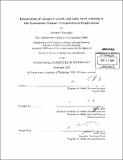| dc.contributor.advisor | Deb K. Roy. | en_US |
| dc.contributor.author | Vosoughi, Soroush | en_US |
| dc.contributor.other | Massachusetts Institute of Technology. Dept. of Architecture. Program in Media Arts and Sciences. | en_US |
| dc.date.accessioned | 2011-04-04T16:29:22Z | |
| dc.date.available | 2011-04-04T16:29:22Z | |
| dc.date.copyright | 2010 | en_US |
| dc.date.issued | 2010 | en_US |
| dc.identifier.uri | http://hdl.handle.net/1721.1/62082 | |
| dc.description | Thesis (S.M.)--Massachusetts Institute of Technology, School of Architecture and Planning, Program in Media Arts and Sciences, 2010. | en_US |
| dc.description | Cataloged from PDF version of thesis. | en_US |
| dc.description | Includes bibliographical references (p. 107-110). | en_US |
| dc.description.abstract | How do characteristics of caregiver speech contribute to a child's early word learning? What is the relationship between a child's language development and caregivers' speech? Motivated by these general questions, this thesis comprises a series of computational studies on the fined-grained interactions of caregiver speech and one child's early linguistic development, using the naturalistic, high-density longitudinal corpus collected for the Human Speechome Project. The child's first productive use of a word was observed at about 11 months, totaling 517 words by his second birthday. Why did he learn those 517 words at the precise ages that he did? To address this specific question, we examined the relationship of the child's vocabulary growth to prosodic and distributional features of the naturally occurring caregiver speech to which the child was exposed. We measured fundamental frequency, intensity, phoneme duration, word usage frequency, word recurrence and mean length of utterances (MLU) for over one million words of caregivers' speech. We found significant correlations between all 6 variables and the child's age of acquisition (AoA) for individual words, with the best linear combination of these variables producing a correlation of r = -. 55(p < .001). We then used these variables to obtain a model of word acquisition as a function of caregiver input speech. This model was able to accurately predict the AoA of individual words within 55 days of their true AoA. We next looked at the temporal relationships between caregivers' speech and the child's lexical development. This was done by generating time-series for each variables for each caregiver, for each word. These time-series were then time-aligned by AoA. This analysis allowed us to see whether there is a consistent change in caregiver behavior for each of the six variables before and after the AoA of individual words. The six variables in caregiver speech all showed significant temporal relationships with the child's lexical development, suggesting that caregivers tune the prosodic and distributional characteristics of their speech to the linguistic ability of the child. This tuning behavior involves the caregivers progressively shortening their utterance lengths, becoming more redundant and exaggerating prosody more when uttering particular words as the child gets closer to the AoA of those words and reversing this trend as the child moves beyond the AoA. This "tuning" behavior was remarkably consistent across caregivers and variables, all following a very similar pattern. We found significant correlations between the patterns of change in caregiver behavior for each of the 6 variables and the AoA for individual words, with their best linear combination producing a correlation of r = -. 91(p < .001). Though the underlying cause of this strong correlation will require further study, it provides evidence of a new kind for fine-grained adaptive behavior by the caregivers in the context of child language development. | en_US |
| dc.description.statementofresponsibility | by Soroush Vosoughi. | en_US |
| dc.format.extent | 110 p. | en_US |
| dc.language.iso | eng | en_US |
| dc.publisher | Massachusetts Institute of Technology | en_US |
| dc.rights | M.I.T. theses are protected by
copyright. They may be viewed from this source for any purpose, but
reproduction or distribution in any format is prohibited without written
permission. See provided URL for inquiries about permission. | en_US |
| dc.rights.uri | http://dspace.mit.edu/handle/1721.1/7582 | en_US |
| dc.subject | Architecture. Program in Media Arts and Sciences. | en_US |
| dc.title | Interactions of caregiver speech and early word learning in the Speechome corpus : computational explorations | en_US |
| dc.type | Thesis | en_US |
| dc.description.degree | S.M. | en_US |
| dc.contributor.department | Program in Media Arts and Sciences (Massachusetts Institute of Technology) | |
| dc.identifier.oclc | 709716879 | en_US |
